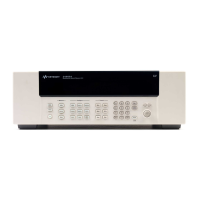52 34980A Service Guide
3 Calibration Procedures
Performance Verification Tests
Use the Performance verification Tests to verify the measurement performance of the
instrument. The performance verification tests use the instrument’s specifications listed
in Chapter 2 Specifications in this manual.
You can perform four different levels of performance verification tests:
• Self-Test A series of internal verification tests that give a high confidence that the
instrument is operational.
• Quick Verification A combination of the internal self-tests and selected verification
tests.
• Performance Verification Tests An extensive set of tests that are recommended as
an acceptance test when you first receive the instrument or after performing
adjustments.
• Optional Verification Tests Tests not performed with every calibration. Perform
these tests to verify additional specifications or functions of the instrument.
Self-Test
A brief power-on self-test occurs automatically whenever you turn on the instrument.
This limited test assures that the instrument is capable of operation and also checks the
plug-in modules for basic operation.
• During the self-test all display segments and annunciators are lit.
• If the self-test fails, the ERROR annunciator turns on. Read any errors using the front
panel View menu, or use the
SYSTem:ERRor? command query from the remote
interface. If repair is required, contact an Agilent Service Center.
• If all tests pass, you have a high confidence (
~
90%) that the instrument is operational.
• You can initiate a more complete self test by sending the
*TST? command to the
instrument. This command returns a “+0” if all the self-tests pass, or a “+1” if a
failure occurred. Depending upon the number and type of modules installed, this
command may take up to 2½ minutes to complete. You may need to set an
appropriate interface time-out value.

